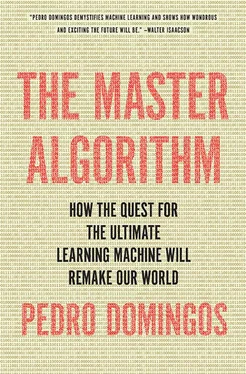This rule arises from a more general principle. Suppose you awake in the middle of the night on a strange planet. Even though all you can see is the starry sky, you have reason to believe that the sun will rise at some point, since most planets revolve around themselves and their sun. So your estimate of the corresponding probability should be greater than one-half (two-thirds, say). We call this the prior probability that the sun will rise, since it’s prior to seeing any evidence. It’s not based on counting the number of times the sun has risen on this planet in the past, because you weren’t there to see it; rather, it reflects your a priori beliefs about what will happen, based on your general knowledge of the universe. But now the stars start to fade, so your confidence that the sun does rise on this planet goes up, based on your experience on Earth. Your confidence is now a posterior probability , since it’s after seeing some evidence. The sky begins to lighten, and the posterior probability takes another leap. Finally, a sliver of the sun’s bright disk appears above the horizon and perhaps catches “the Sultan’s turret in a noose of light,” as in the opening verse of the Rubaiyat . Unless you’re hallucinating, it is now certain that the sun will rise.
The crucial question is exactly how the posterior probability should evolve as you see more evidence. The answer is Bayes’ theorem. We can think of it in terms of cause and effect. Sunrise causes the stars to fade and the sky to lighten, but the latter is stronger evidence of daybreak, since the stars could fade in the middle of the night due to, say, fog rolling in. So the probability of sunrise should increase more after seeing the sky lighten than after seeing the stars fade. In mathematical notation, we say that P(sunrise | lightening-sky) , the conditional probability of sunrise given that the sky is lightening, is greater than P(sunrise | fading-stars) , its conditional probability given that the stars are fading. According to Bayes’ theorem, the more likely the effect is given the cause, the more likely the cause is given the effect: if P(lightening-sky | sunrise) is higher than P(fading-stars | sunrise) , perhaps because some planets are far enough from their sun that the stars still shine after sunrise, then P(sunrise | lightening sky) is also higher than P(sunrise | fading-stars) .
This is not the whole story, however. If we observe an effect that would happen even without the cause, then surely that’s not much evidence of the cause being present. Bayes’ theorem incorporates this by saying that P(cause | effect) goes down with P(effect), the prior probability of the effect (i.e., its probability in the absence of any knowledge of the causes). Finally, other things being equal, the more likely a cause is a priori, the more likely it should be a posteriori. Putting all of these together, Bayes’ theorem says that
P(cause | effect) = P(cause) × P(effect | cause) / P(effect).
Replace cause by A and effect by B and omit the multiplication sign for brevity, and you get the ten-foot formula in the cathedral.
That’s just a statement of the theorem, not a proof, of course. But the proof is surprisingly simple. We can illustrate it with an example from medical diagnosis, one of the “killer apps” of Bayesian inference. Suppose you’re a doctor, and you’ve diagnosed a hundred patients in the last month. Fourteen of them had the flu, twenty had a fever, and eleven had both. The conditional probability of fever given flu is therefore eleven out of fourteen, or 11/14. Conditioning reduces the size of the universe that we’re considering, in this case from all patients to only patients with the flu. In the universe of all patients, the probability of fever is 20/100; in the universe of flu-stricken patients, it’s 11/14. The probability that a patient has the flu and a fever is the fraction of patients that have the flu times the fraction of those that have a fever: P(flu, fever) = P(flu) × P(fever | flu) = 14/100 × 11/14 = 11/100. But we could equally well have done this the other way around: P(flu, fever) = P(fever) × P(flu | fever) . Therefore, since they’re both equal to P(flu,fever), P(fever) × P(flu | fever) = P(flu) × P(fever | flu) . Divide both sides by P(fever) , and you get P(flu | fever) = P(flu) × P(fever | flu) / P(fever) . That’s it! That’s Bayes’ theorem, with flu as the cause and fever as the effect.
Humans, it turns out, are not very good at Bayesian inference, at least when verbal reasoning is involved. The problem is that we tend to neglect the cause’s prior probability. If you test positive for HIV, and the test only gives 1 percent false positives, should you panic? At first sight, it seems like your chances of having AIDS are now 99 percent. Yikes! But let’s keep a cool head and apply Bayes’ theorem step-by-step: P(HIV | positive) = P(HIV) × P(positive | HIV) / P(positive) . P(HIV) is the prevalence of HIV in the general population, which is about 0.3 percent in the United States. P(positive) is the probability that the test comes out positive whether or not you have AIDS; let’s say that’s 1 percent. So P(HIV | positive) = 0.003 × 0.99 / 0.01 = 0.297. That’s very different from 0.99! The reason is that HIV is rare in the general population. The test coming out positive increases your chances of having AIDS by two orders of magnitude, but they’re still less than half. If you test positive for HIV, the right thing to do is to stay calm and take another, more definitive test. Chances are you’ll be fine.
Bayes’ theorem is useful because what we usually know is the probability of the effects given the causes, but what we want to know is the probability of the causes given the effects. For example, we know what percentage of flu patients have a fever, but what we really want to know is how likely a patient with a fever is to have the flu. Bayes’ theorem lets us go from one to the other. Its significance extends far beyond that, however. For Bayesians, this innocent-looking formula is the F = ma of machine learning, the foundation from which a vast number of results and applications flow. And whatever the Master Algorithm is, it must be “just” a computational implementation of Bayes’ theorem. I put just in quotes because implementing Bayes’ theorem on a computer turns out to be fiendishly hard for all but the simplest problems, for reasons that we’re about to see.
Bayes’ theorem as a foundation for statistics and machine learning is bedeviled not just by computational difficulty but also by extreme controversy. You might be forgiven for wondering why: Isn’t it a straightforward consequence of the notion of conditional probability, as we saw in the flu example? Indeed, no one has a problem with the formula itself. The controversy is in how Bayesians obtain the probabilities that go into it and what those probabilities mean. For most statisticians, the only legitimate way to estimate probabilities is by counting how often the corresponding events occur. For example, the probability of fever is 0.2 because twenty out of one hundred observed patients had it. This is the “frequentist” interpretation of probability, and the dominant school of thought in statistics takes its name from it. But notice that in the sunrise example, and in Laplace’s principle of indifference, we did something different: we pulled a probability out of thin air. What exactly justifies assuming a priori that the probability the sun will rise is one-half, or two-thirds, or whatever? Bayesians’ answer is that a probability is not a frequency but a subjective degree of belief. Therefore it’s up to you what you make it, and all that Bayesian inference lets you do is update your prior beliefs with new evidence to obtain your posterior beliefs (also known as “turning the Bayesian crank”). Bayesians’ devotion to this idea is near religious, enough to withstand two hundred years of attacks and counting. And with the appearance on the stage of computers powerful enough to do Bayesian inference, and the massive data sets to go with it, they’re beginning to gain the upper hand.
Читать дальше












